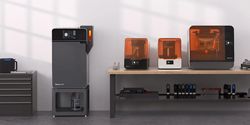3D Printing in Drone Manufacturing
For drone manufacturers, 3D printing can improve lead times, reduce costs, and gain more control over workflows with stereolithography (SLA) and selective laser sintering (SLS) 3D printing technology.
Researchers 3D print working drone with embedded electronics
The Engineer: Researchers at Nanyang Technological University, Singapore (NTU Singapore) have 3D printed a ready-to-fly drone with embedded electronics using an aerospace-grade material.
The electronics were incorporated in the drone during the 3D printing process, which employs Stratasys’ ULTEM 9085, a high strength, lightweight FDM (fused deposition modelling) material certified for use in commercial aircraft. Cont'd...
3-D-printed robots with shock-absorbing skins
Adam Conner-Simons for MIT News: Anyone who’s watched drone videos or an episode of “BattleBots” knows that robots can break — and often it’s because they don’t have the proper padding to protect themselves.
But this week researchers at MIT’s Computer Science and Artificial Intelligence Laboratory(CSAIL) will present a new method for 3-D printing soft materials that make robots safer and more precise in their movements — and that could be used to improve the durability of drones, phones, shoes, helmets, and more.
The team’s “programmable viscoelastic material” (PVM) technique allows users to program every single part of a 3D-printed object to the exact levels of stiffness and elasticity they want, depending on the task they need for it. Cont'd...
Records 1 to 3 of 3
Featured Product

Quality assurance in the manufacturing industry
Efficiency and precision with CSP software. In the highly competitive world of manufacturing, quality assurance is a critical factor for success. CSP offers you state-of-the-art software solutions specifically designed to ensure the highest standards of quality assurance in the manufacturing industry.
Manufacturing and Automation - Featured Company

KEB America, Inc.
KEB America is a trusted manufacturer of industrial automation products in North America. We manufacture, assemble, and support our German-engineered suite of controls, drives, motors, brakes, and clutches at an ISO 9001:2015 certified, 150,000-square-foot facility in Shakopee, Minnesota.

